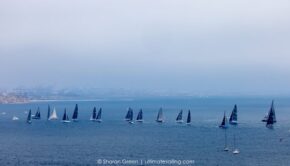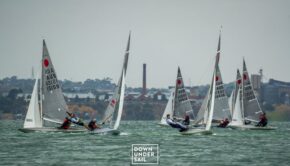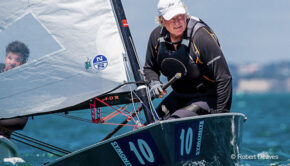On the Topic of Transparency
Published on September 19th, 2016
James Dadd, chief measurer for the IRC rating rule, has been on a world tour. As one of two international rating rules to handicap different designs of keelboats (the other being ORC), Dadd has been both educator and student. Here is his report as published in the September issue of Seahorse magazine…
One issue that seems to raise its head constantly when discussing any rating rule today is most often referred to as ’transparency’. This word always seems to be at the tip of many people’s tongues when talking about the pros and cons of different rating systems.
There are many elements to any rating rule, or class rule for that matter. There is the management structure, the consultation process, the rule policies and the software structure plus the detail controls… to name just a handful. But I see it that the priority from the user’s perspective is an understanding of what we are doing, how and why.
With IRC we have always been fully open about our intentions. That goes back to one of the fundamental objectives of the Royal Ocean Racing Club: ‘to study and encourage the design, building, navigation and sailing of sailing vessels in which speed and seaworthiness are combined by any means including scientific research and practical demonstration’.
It is also clarified in the fundamental policies of IRC, which are to encourage design innovation consistent with stability, rounded performance, seaworthiness and safety, as well as to discourage unnecessary expense at all levels. A full read of the IRC Fundamental Policy (rule 2) is worth doing every now and then. This has not changed and is probably the rule I refer to most when asked questions about IRC.
However, the part of the rule that the detractors say needs ‘transparency’ is the software. We do not try to hide in any way that IRC is based on the same laws of physics as any other performance prediction model, and that we are trying to emulate that as closely as possible while maintaining the requirements of our fundamental policies as well as the objectives of the RORC and UNCL – our partner in the IRC rating system.
The clear intention when discussing the rating software is that sailors should look at trying to make their boat perform as well as possible rather than make their rating as low as possible.
We freely admit that the focus of IRC has always been, and will always be, to protect the existing fleet (Rule 2.2) and to encourage racing in cruising yachts and in ballasted racing keelboats.
So don’t expect the software to encourage people to modify their boats to accept Dali foils for a rating benefit just yet.
So the overall approach of the IRC software is to rate performance affecting elements along the same lines as the actual performance. We do our best to get this as accurate as possible without encouraging unnecessary expense in terms of increased measurement costs when we feel that the basic information already tells us what we need. Again, as Einstein said, ‘Everything should be made as simple as possible but no simpler.’
But as with pretty much everything, the devil is in the detail. We have seen in history that rating rules don’t get broken at the fundamental level; IMS and IOR, for example, produced very nice boats for their time when they first got used internationally. It was only over time as the designers started to examine the detail that the over-compensation for having the LCB too far aft in IMS was hungrily seized upon, or that wooden keel shoes in IOR were seen to make the boat slower in the rating software than in reality.
In IRC we are open and transparent about what the designer and crew should be aiming for: make the boat work as well as you can, as you won’t get a benefit for getting it wrong. If the boat is out of balance, correct it, don’t expect us to compensate for it. Go out whenever possible and try a new trim, practice and play around with your boat to get the most out of it.
If a configuration doesn’t work that well, don’t ask your designer to look into the rule and figure out whether to make the boat work better or worse on the water based on which is rated better. IRC is transparent, and as such the answer to this quandary is always going to be to make it work better, don’t slow it down and expect your rating to drop more than your performance.
I don’t believe there is a more transparent methodology that encourages you to sail your boat as well as possible and set it up the best you can, and as simply as you can, than the one now in use around this small island. Thus my travels to reinforce and discuss the IRC ‘message’ at venues including Auckland, Sydney, Melbourne, Perth, Thailand, Spain and France.
My ‘lap’ was then followed by a very useful trip to Newport, RI, initially to discuss the evolution of IRC in the Maxi72 fleet. However, we also talked at length about where we are heading with the NYYC, Storm Trysail Club, Cruising Club of America and US Sailing; at the same round of meetings we cemented our position with the International Maxi Association, with the RORC rating office becoming the hub for the IMA’s technical operation.
There is an argument in Australia, and in North America, that IRC is seen as too grand prix for their ‘regular’ level of event. It is true that most images you will see in this magazine and others are of grand prix boats racing under IRC, but that is not the origin, nor where the vast majority of IRC racing happens.
We hope to expand the appreciation of this fact and use that better understanding to help us to expand the use of standard IRC data. This should make the transition from club racing to grand prix far easier as there is no transition from system to system, just a gradual change from declared data to official data.
Two elements that I will write more about in the future that came from the meetings in Paris and Newport are the way that IRC deals with keel bulb weight and the current trend to move ballast from the bulb into the keel fin. We don’t see this as a sensible long-term solution as it requires a more complex structure. So we will gradually shift the other way and if a keel has a bulb ensure that the lead is where you would expect it, down in the bulb.
I must admit that my recent travels have opened my eyes even more to the diversity in our sport… even in such a seemingly dry arena as rating monohull keelboats!
Seahorse is the dominant international magazine for anyone serious about their racing. Take advantage of their subscription offer or order a single copy of Seahorse online at www.seahorse.co.uk/shop or for iPad download the Seahorse App at the iTunes store. Contact by email at subscriptions@seahorse.co.uk.









 We’ll keep your information safe.
We’ll keep your information safe.